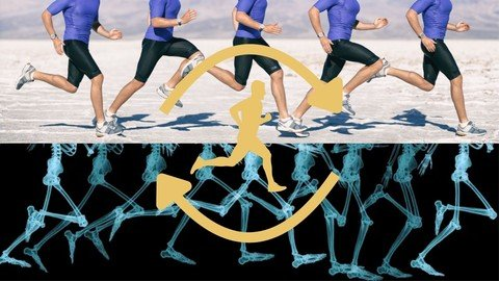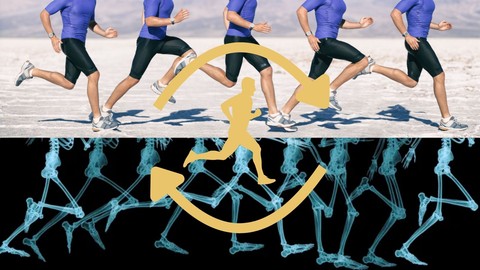LeeAndro
MyBoerse.bz Pro Member

Published 4/2024
MP4 | Video: h264, 1920x1080 | Audio: AAC, 44.1 KHz
Language: English | Size: 1.31 GB | Duration: 1h 22m
Optimize Your Own Gait: Get To Know The Biomechanics Of The Joints, The Phases Of The Gait Cycle & How To Analyze Gait
What you'll learn
Learn how the gait cycle forms the foundation for all athletic movements
Get to know each individual phase of the human gait cycle
Understand how the biomechanics change during the respective phase
Become familiar with the basics about biomechanics
Learn how the running gait cycle differs from the walking gait cycle
Optimize your own walking and running technique
Requirements
Interest in understanding how we move
Description
IMPROVE YOUR WALKING & RUNNING TECHNIQUE BY UNDERSTANDING THE BIOMECHANICS!Even if you are not a runner, understanding the gait cycle and the typical patterns of your specific gait is fundamental for biomechanical analysis. Analyzing gait is the main tool of diagnostics for biomechanists - similar to what a MRI scan means for a doctor.This course aims to help you to optimize your own walking or running technique. For that, we first need to understand the biomechanics of the lower extremity joints and the main principles of gait in general. Then, we can separate the gait cycle into different phases and analyze the biomechanics of each of them individually. Moreover, we will look into the keys of energy conservation and look at certain movement patterns that make walking and running more efficient. Ultimately, you will be able to perform a full gait analysis on yourself and determine how you can address certain issues and conduct possible improvements.Understanding The Gait Cycle Is Fundamental For Pursuing A Successful Career In Biomechanics.As a studied biomechanist myself, I study the science of human locomotion and find ways to analyze and optimize movements. This course contains lots of valuable scientifically proven knowledge that I have gained over the years studying and working in the field of biomechanics, put together into 25+ lectures and over 1.5 hours of content. Let me share it with you!After finishing this course, you will be able to:Understand how the gait cycle forms the foundation of all movements in sportsKnow the details of each individual phase of the walking and the running gait cycleUnderstand the anatomy and the function of the joints of the lower bodyUnderstand the biomechanical differences between walking and runningOptimize your own walking and running techniqueThe following questions will be answered in this course:IntroductionHow is the course structuredWhy is the gait cycle so important to understand for biomechanical analysisWhich terms to describe movements and locations are used in the field of biomechanicsBiomechanics Of The JointsHow are the joints of the human body builtWhich types of joints are thereHow exactly do the joints of the lower extremities functionThe Walking Gait CycleWhat are stance and swing phase and which subphases belong to themHow are the biomechanics changing during each phase of the gait cycleHow do the kinematics and kinetics of walking allow us to move more efficientlyThe Running Gait CycleHow are the biomechanics changing during the phases of the running gait cycleWhat are the biomechanical differences between walking and runningWhich elastic mechanisms help us to minimize the energy expenditure while runningGait AnalysisHow can we analyze our own gaitWhat needs to be considered when performing a gait analysisWhat are some atypical movement patterns that are very common among many peopleOf course, there is a 30-day money-back guarantee from Udemy. Feel free to enroll now to see if this course is for you!
Overview
Section 1: Introduction
Lecture 1 Welcome To This Online Course!
Lecture 2 Course Structure & Overview
Lecture 3 The Importance Of The Gait Cycle
Lecture 4 Planes & Axes
Lecture 5 Location & Movement Terminology
Section 2: Biomechanics Of The Joints
Lecture 6 Anatomy & Functioning Of Joints
Lecture 7 Joint Types
Lecture 8 Function Of The Pelvis
Lecture 9 Function Of The Hip Joint
Lecture 10 Anatomy Of The Knee Joint
Lecture 11 Function Of The Ankle Joint
Section 3: The Walking Gait Cycle
Lecture 12 Definition & Parameters
Lecture 13 Stance Phase
Lecture 14 Swing Phase
Lecture 15 Walking Kinematics
Lecture 16 Arm Swing
Section 4: The Running Gait Cycle
Lecture 17 Definition & Parameters
Lecture 18 Running Kinematics
Lecture 19 Elastic Mechanisms
Section 5: Gait Analysis
Lecture 20 Analyzing Your Own Gait
Lecture 21 Atypical Gait
Lecture 22 Conclusion
Section 6: Additional Content
Lecture 23 Location & Movement Terminology
Lecture 24 Joint Types
Lecture 25 Phases Of The Gait Cycle
Lecture 26 Muscle Map
Lecture 27 Bone Map
Anybody who is interested in the human biomechanics
HomePage:
DOWNLOAD
rapidgator
nitroflare







